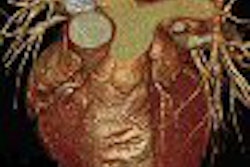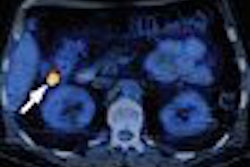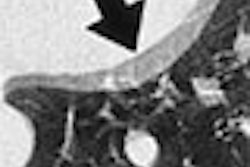AuntMinnie.com is pleased to present the second half of our two-part series on avoiding contrast-related nephropathy. In the second installment, nephrologist Dr. Richard Solomon from the University of Vermont discusses preventive strategies for imaging the at-risk patients defined in part I of the series.
A whole toolbox of preventive strategies can be unlocked to prevent contrast-induced nephropathy in the at-risk imaging patient. In a talk at the 2005 International Symposium on Multidetector-Row CT in San Francisco, nephrologist and iodinated contrast expert Dr. Richard Solomon from the University of Vermont held up each one for review, separating the proven risk-reduction tools from those that may not work, based on researchers' current understanding of pathophysiology.
Iodinated contrast administration impacts the kidney in at least two ways, Solomon said. "It produces renovasal construction and tubular toxicity that leads to contrast-induced renal insufficiency."
Prevention strategies are aimed at "making the kidney less vulnerable," he said, "in some way mitigating vasoconstriction induced by the contrast agent, reducing oxidative stress which appears to encourage part of a perfusion reperfusion injury, and then using the minimal amount of contrast and choosing the right contrast agent."
Patient factors associated with the vulnerable kidney include renal insufficiency, congestive heart failure, endothelial dysfunction, diabetes, drug regimens, and most important, volume depletion.
Volume, volume, volume
Inadequate volume is the most important factor on the list, and it is preventable. "Volume enhances the removal of contrast, while protecting the kidney from oxidative stress," Solomon said.
A study his group conducted a decade ago showed that giving saline, as opposed to what was then the standard of care (saline plus mannitol or saline and furosimide), significantly reduced the incidence of contrast-induced renal insufficiency, he said.
"Among the 28 patients in the saline group, three (11%) had such an increase in serum creatinine, as compared with seven of 25 in the mannitol group (28%) and 10 of 25 in the furosimide group (40%) (p = 0.05)" after contrast administration, the group wrote (New England Journal of Medicine, November 24, 1994, Vol. 331:21, pp. 1416-1420).
"When you gave things like mannitol or furosimide, you actually made the situation worse," he said of the study. Unfortunately, the 1994 saline protocol required the drip to begin the night before imaging, too impractical and expensive in today's healthcare environment. In the meantime, great efforts have been expended to initiate the most effective volume-expanding protocol, Solomon said.
Among them, a new prophylaxis based on intra-arterial infusion of 154 mEq/L of sodium bicarbonate was found to be more effective than an equal dose of sodium chloride, he said. About 3 mL per kilogram of body weight, an hour before contrast injection and for six hours thereafter, does the job.
According to the study authors, "the primary end point of contrast-induced nephropathy occurred in eight patients (13.6%) infused with sodium chloride but in only one (1.7%) of those receiving sodium bicarbonate (mean difference, 11.9%; 95% confidence interval [CI], 2.6%-21.2%; p = 0.02)," the authors wrote of the comparative study (Journal of the American Medical Association, May 19, 2004, Vol. 291:19, pp. 2328-2334).
Still, the ideal hydration protocol has yet to be identified, Solomon said. But it's clear that diuresis has a key protective effect, he said.
"We don't know the mechanism, but ... in all of these trials that look for volume-expanding techniques, when you got the kidney peeing at 100-150 ccs an hour, you protect it against a high incidence of contrast-induced nephropathy," Solomon said.
"What does it mean for your practice? Don't make people NPO (nothing by mouth)," he said. "They should be encouraged to drink fluid liberally the night before -- even the morning of a study if they're not immediately going for their contrast CT."
Vasodilators ineffective
As for preventing renal ischemia, there have been many studies that gave vasodilators, but none of them, unfortunately, have proved effective in prospective randomized trials, according to Solomon. Atrial natriuretic peptide had no benefit. Dopamine had no benefit. Endothelin antagonists and fenoldopam mesylate had no benefit. Calcium channel blockers have been inadequately studied.
They have no benefit "mostly because they're given systemically and they induce hypotension, and that has an adverse effect on the kidney," Solomon said. "So when we get around to having either more specific renal vasodilators, or can deliver the renovasal dilators directly into the kidney, they may work. So the story's not over, but nobody is using renal vasodilators as part of their prophylaxis of contrast-induced nephropathy."
NAC it, now you don't
Then there is tubular toxicity, which is manifested by an increase in reactive oxygen species. Tubular toxicity prophylaxis is where N-acetylcysteine got its very promising start. But the results have been quite variable, "with the end result being that we're not so sure that acetylcysteine really does anything," Solomon said, referencing a meta-analysis by Pannu et al (Kidney International, April 2004, Vol. 65:4, pp. 1366-1374).
"The bottom line is that ... maybe there are some patients who benefit (while) others don't benefit," he said. "(NAC) is easy to give; it's inexpensive. Do we know the right dose? No. Do we know the right way to give it -- intra-arterially, orally? No. If you want to use it fine, but it's not a substitute for doing the other things that are prophylactic."
Contrasts in contrast
Finally there are variables in the contrast media itself, distinguished in myriad ways such as osmolality, ionicity, monomers, dimers, viscosity, and more. Osmolality is the quality that has gotten the most attention in terms of its potential to reduce the risk of nephropathy.
Low osmolality contrast media was shown to reduce the risk significantly, in fact, in a 1993 meta-analysis of 31 trials that compared high- and low-osmolality formulations head to head in 5,146 high-risk patients (Radiology, July 1993, Vol. 188:1, pp. 171-178).
Among 25 applicable trials, the pooled odds of a rise in serum creatinine level exceeding 44 mumol/L after administration of low-osmolality contrast media was 0.61 (95% CI, 0.48-0.77) times the odds after high-contrast media administration. For the subset of patients with existing renal failure, this odds ratio was 0.5 (CI, 0.36-0.68), compared to 0.75 (CI, 0.52-1.1) in patients without prior renal failure, the study authors wrote.
The 50% reduction of rising creatinine in patients with renal failure was significant, Solomon said, while the 25% reduction in patients without renal failure was not. Now there is evidence that lower osmolality, or iso-osmolar agents, reduce the risk even further. A four-year study at the University of Minnesota compared the iso-osmolar agent iodixanol to low-osmolar iohexol in several groups of high-risk patients.
"A subgroup with severe chronic kidney disease and diabetes mellitus with iodixanol had a significantly lower creatinine increase (n = 25, 0.09 ± 0.5 mg/dL), compared to historical controls (n = 42, 0.7 ± 0.8 mg/dL) with iohexol (p < 0.001)," the authors wrote in their abstract. Moreover, administering greater volumes of the iso-osmolar agent appeared to produce little incremental harm. A nonsignificant negative correlation was also found between the volume of iodixanol and the change in creatinine (r2 = 0.0011, p = 0.7254) (Journal of Invasive Cardiology, April 2005, Vol. 17:4, pp. 211, 215).
Still, Solomon cautioned, nephrotoxicity was not strictly correlated to osmolality, and indeed, the high amount of "scatter" in the results indicates that "osmolality is not the whole story," he said. "There are other characteristics ... that are important in the production of contrast-induced nephropathy."
Recommendations for patients
Solomon ended with a series of recommendations that he emphasized were based on his opinion of how the risk of contrast-induced nephropathy could be reduced.
Identify high-risk patients by GFR (< 60 mL/min/1.73 m2), also accounting for age, gender, and race (MDRD).
Give plenty of volume. Avoid NPO orders before the study.
Prevent subtle volume depletion by stopping diuretics a day before the study, giving an IV in patients who are likely to be volume-depleted. Sodium bicarbonate infusion for one hour prior to contrast media exposure may be adequate.
Use the lowest volume of contrast needed for imaging, as determined by organ imaged, body habitus, noise tolerance, etc.
Use a contrast agent with a low incidence of contrast-induced nephropathy.
Add N-acetylcysteine when possible. A double dose (1200 bid x 48 hours) may be more protective.
Continue IV fluids (1 mL/kg/hour) for up to six hours after the study when possible.
Follow-up serum creatinine the day after the study.
"You'll never know if the patient has contrast-induced nephropathy if you don't get a follow-up creatinine," Solomon said.
For more information, access the Reston, VA-based American College of Radiology's Manual on Contrast Media, available free of charge on the organization's Web site.
By Eric Barnes
AuntMinnie.com staff writer
September 20, 2005
Related Reading
Part I: Identifying patients at risk of contrast-induced nephropathy, September 13, 2005
N-acetylcysteine does not prevent contrast-induced nephropathy, June 7, 2005
Iodixanol more cost-effective than iohexol in renal angiography, April 14, 2005
N-acetylcysteine prevents contrast agent-associated nephropathy, September 6, 2004
Sodium bicarbonate may prevent radiocontrast-induced renal injury, May 19, 2004
Copyright © 2005 AuntMinnie.com



















